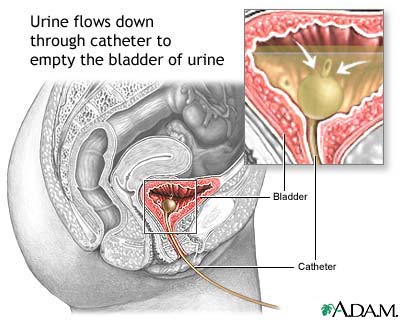Alternate Names : Obstructive uropathy – bilateral – chronic, Kidney failure – chronic blockage
Definition
Chronic bilateral obstructive uropathy is a long-term blockage of urine flow from both kidneys. It is a slow blockage that gets worse over time.
Bilateral means “both sides.”
See also:
- Chronic unilateral obstructive uropathy
- Acute unilateral obstructive uropathy
- Acute bilateral obstructive uropathy
Overview, Causes, & Risk Factors
The most common cause of chronic bilateral obstructive uropathy is a condition called bladder outlet obstruction. The kidneys produce urine in the normal manner but the urine cannot leave the bladder. Urine backs up, causing kidney swelling and damage.
When the blockage causes urine to back up into both kidneys, hydronephrosis (swelling of the kidneys) results. High blood pressure and kidney failure can result.
In men, chronic bilateral obstructive uropathy is most often a result of benign prostatic hyperplasia (BPH).
Other causes of chronic bilateral obstructive uropathy include:
- Bladder tumors
- Prostate tumors
- Tumors or masses of the uterus or other structures around the bladder neck or urethra
- Retroperitoneal fibrosis
- Narrowing of the urethra due to a birth defect or scar tissue
Chronic bilateral obstructive uropathy occurs in about 1 out of every 1,000 people.
Pictures & Images
Bladder catheterization, female
 A catheter (a hollow tube, often with an inflatable balloon tip) may be inserted into the urinary bladder when there is a urinary obstruction, following surgical procedures to the urethra, in unconscious patients (due to surgical anesthesia, coma, etc.), or for any other problem in which the bladder needs to be kept empty (decompressed) and urinary flow assured.
A catheter (a hollow tube, often with an inflatable balloon tip) may be inserted into the urinary bladder when there is a urinary obstruction, following surgical procedures to the urethra, in unconscious patients (due to surgical anesthesia, coma, etc.), or for any other problem in which the bladder needs to be kept empty (decompressed) and urinary flow assured.
Bladder catheterization, male

Catheterization is accomplished by inserting a catheter (a hollow tube, often with and inflatable balloon tip) into the urinary bladder. This procedure is performed for urinary obstruction, following surgical procedures to the urethra, in unconscious patients (due to surgical anesthesia, coma, etc.), or for any other problem in which the bladder needs to be kept empty (decompressed) and urinary flow assured. Catheterization in males is slightly more difficult and uncomfortable than in females because of the longer urethra.
-
Chronic bilateral obstructive uropathy : Overview, Causes, & Risk Factors
-
Chronic bilateral obstructive uropathy : Symptoms & Signs, Diagnosis & Tests
-
Chronic bilateral obstructive uropathy : Treatment



Review Date : 1/10/2010
Reviewed By : David Zieve, MD, MHA, Medical Director, A.D.A.M., Inc., and Louis S. Liou, MD, PhD, Assistant Professor of Urology, Department of Surgery, Boston University School of Medicine.
